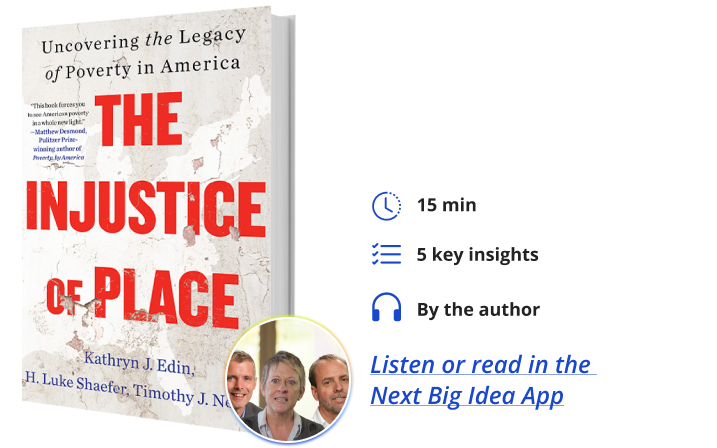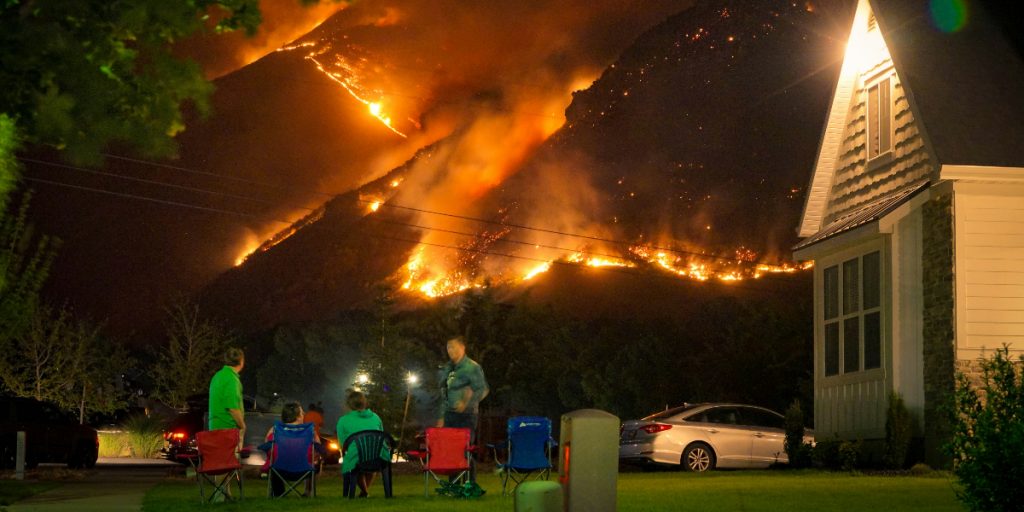H. Luke Shaefer is the Hermann and Amalie Kohn Professor of Social Justice and Social Policy at the University of Michigan Ford School of Public Policy. He also directs Poverty Solutions, a university-wide initiative that partners with communities and policymakers to find new ways to prevent and alleviate poverty.
Kathryn Edin is the William Church Osborn Professor of Sociology and Public Affairs at Princeton University. Edin was named a Bloomberg Distinguished Professor at John Hopkins University for her accomplishments as an interdisciplinary researcher and excellence in teaching. Edin was also elected as a member of the American Academy of Arts and Sciences in 2019.
Timothy Nelson is a Lecturer in the Department of Sociology at Princeton University. Nelson received his PhD in sociology from the University of Chicago and has taught at Johns Hopkins, Harvard, Northwestern, and the University of Pennsylvania.
Below, Luke, Kathryn, and Timothy share 5 key insights from their new book, The Injustice of Place: Uncovering the Legacy of Poverty in America. Listen to the audio version—read by co-author Luke—in the Next Big Idea App.

1. The most disadvantaged places in the nation are in rural America—but they don’t look like what you might think!
When President Lyndon Johnson declared an “unconditional war on poverty” in 1964, the nation lacked any method of counting the poor, or even a firm notion of how poverty should be defined. His administration scrambled to come up with a measure to chart progress. The gauge became the minimum income needed for a family to put food on the table, multiplied by three because, at the time, food was a third of the typical family budget.
Income is one vital indicator of well-being, but it is not the only one: Things like health outcomes and social mobility matter, too. That’s why we should shift our focus from “poverty” to “disadvantage.” Disadvantage is a more useful term than poverty because we aren’t just talking about income, we’re trying to capture the complexity of a person’s life chances being hindered by multiple circumstances. Disadvantage is more accurate because it implies an injustice. People are being held back—unfairly.
With this in mind, we created what we call the Index of Deep Disadvantage, which reflects two traditional measures of income (the poverty rate and the “deep poverty rate,”), two markers of health (birth weight and life expectancy), and the rate of social mobility for children who grow up in low-income families. We used this index to rank the roughly 3,100 counties in the United States along with the 500 most populous cities.
Immediately, the rankings revealed a stark geographic pattern. The first surprise—especially for professors who have spent our careers studying urban poverty—was that the most disadvantaged places on our index were primarily rural. But they didn’t fit the stereotypical image of rural America. While some of these were majority-white, most had majority Black or Hispanic populations. We could see, too, that many places with large Native American populations ranked among the most disadvantaged in the nation. Considerable poverty exists in cities like Chicago and Los Angeles. But in our apples-to-apples comparison, neither of those cities ranked among even the 600 most disadvantaged places in the nation. The only cities that were among the most disadvantaged were a relatively small number of industrial municipalities such as Cleveland and Detroit.
Some might say we should have taken into account the high cost of living in some cities, but we argue that the issues here are more complicated than it might appear. Although people pay more for housing in some places, they also benefit from good health care systems, a more generous safety net, public transportation, and higher-quality schools. Additionally, those living in the 200 most disadvantaged places on our index were just as prone to have major difficulties paying for housing as those in America’s 500 largest cities.
The circumstances faced in these places are striking. Those living in America’s most disadvantaged communities can expect to die nearly a decade earlier than those living in the most advantaged places. The unemployment rate in these places is about three times higher than in the most advantaged places. In many of these places, rates of violent crime are similar to those seen in cities like Chicago. Across every factor we were able to examine, these were truly the most disadvantaged places in America.
2. The stories of these regions of deep disadvantage are linked together—we can think of them as Internal Colonies.
The places that our index identified as most disadvantaged are concentrated in three regions—Appalachia, South Texas, and the vast southern Cotton Belt. These places share a history of intensive resource extraction and human exploitation unseen to the same degree elsewhere in the United States. In each place, this economic pattern emerged (or, in the case of the Cotton Belt, fully flourished) in the late 19th or early 20th century. In each place, one industry came to dominate the economy, a pattern that held, broadly, into the 1960s, when King Cotton, King Tobacco, and King Coal would bow to the twin forces of automation and global competition.
We would have had to be exceedingly dull or stubborn to have missed the fact that these places resembled, well, colonies. Internal colonies within the U.S. using terminology such as “nation within a nation” or “colony” to describe the exploitation of communities of color within the United States has a long history among Black scholars and activists. While visiting many of the nation’s most disadvantaged places, we set out to build on their work through historical research, ethnographic observations, and in-depth interviews.
In central Appalachia, we drove through the remnants of company towns, often only one or two streets wide, and the hollows—narrow valleys that can stretch for miles between the mountains. We came to Clay County, Kentucky, which before the Civil War was home to both mighty salt barons, and a tapestry of subsistence farms. Big Timber and Big Coal took over after the Civil War. Today, the opioid crisis is ravaging the region. Locals in Manchester, the county seat, lament the decline of the movie theater—now a Pentecostal church—and the loss of the bowling alley, numerous bars, cafés, and beauty salons. A local park has been plowed under for a highway construction project. People blame the rise of opioid use on the fact that there is now “nothing to do but drugs.”
“These places share a history of intensive resource extraction and human exploitation unseen to the same degree elsewhere in the United States.”
In South Texas, spinach and onion fields were once so vast they met the sky’s vanishing point in almost every direction, yielding fabulous profits for those who owned the land. Yet the landless laborers who planted and harvested those crops faced unimaginable hardship. For generations, the appearance of towns in South Texas followed a pattern of social hierarchy: sturdy wood-frame houses, paved streets, and enclosed sewers in the white neighborhoods; shacks, dirt roads, and privies in the Mexican parts of town. Forced to migrate to find work during the off-season, generations of Mexican American children lost their right to a decent education. Even today, adult illiteracy rates in these places are among the highest in the nation.
When we hit the outskirts of the typical Cotton Belt Town, fields gave way to a string of gleaming white antebellum homes with large lawns, old-growth trees, and grand entrances framed by columns reaching two or three stories high. These places seem serene on their face, yet in Leflore County, Mississippi, for example, Black residents said violence was the number one problem they face. The rate of death due to interpersonal violence there was nearly four times the national average, and well above that of Cook County in Chicago.
As we would soon learn, this county and the larger region it represents—the vast Cotton Belt stretching from the Carolinas to eastern Arkansas and Louisiana—is indeed among the most dangerous in the nation. These places have a long tradition of violence, both accepted and sponsored by the government. For generations, it was the greatest tool at the disposal of the white elite to oppress Black Americans into labor.
Throughout these regions, we saw the same themes emerge again and again—unequal schooling, the collapse of social infrastructure, violence, entrenched public corruption, and structural racism embedded in government programs.
3. Too many communities are hindered by government corruption.
Head to any of the most disadvantaged places in America and ask local leaders what is holding their community back. Invariably, you will hear a story about the local poor. They don’t want to work, don’t behave like they should, and have become dependent on government welfare programs. This narrative is centuries old. Indeed, the narrative of the shiftless poor inhabits a perpetual space in the nation’s collective consciousness.
These days, though, the biggest story about welfare cheats isn’t about the poor making off with undeserved aid. Any such fraud is dwarfed by the actions of nonprofit and government leaders in Mississippi, who scammed a government program meant to help the state’s very poor children, to the tune of nearly $80 million. It’s the largest government corruption scandal in state history.
The Mississippi welfare scandal might not have made national headlines except for the involvement of Super Bowl champion quarterback Brett Favre. Pulitzer Prize-winning reporter Anna Wolfe uncovered the scheme. The scam was the brainchild of Nancy New, a nonprofit leader from the Delta community of Greenwood, Mississippi. Among the alleged crimes: working in league with state officials to fund activities that the state auditor, Shad White, can find no evidence ever took place. Favre was paid $1.1 million by New’s nonprofit for speaking events that, according to White, did not occur.
Through more than 100 interviews with local leaders in America’s most disadvantaged communities, we learned that many local elites assume that, unless proven otherwise, the poor are eager to take advantage of the dole, a guilty-until-proven-innocent frame. We learned that the same people who are eager to blame the poor will often discount a case like New’s, dismissing it as just one bad apple. But we saw firsthand how local elites all too often exploit their communities’ meager resources. This includes even the aid meant to help the community’s poorest. There exists corruption of all kinds, a pattern enduring across generations in these places, not only of desperate poverty but also of considerable wealth.
“In the words of John Kerry, civic corruption is an opportunity destroyer.”
In one small south Texas town in 2016, the mayor, the city manager, and three current or former members of the city council were charged as part of a conspiracy and bribery scheme. In the same town, another council member had already gone down on human trafficking charges, leaving only one member of the city council to run the local government.
In 2007, in Manchester, Kentucky, which ranks among the country’s most disadvantaged places, the city’s long-serving mayor Daugh White and several of his cronies pleaded guilty to racketeering and conspiracy charges for seeking kickbacks from companies bidding on city contracts. In 2006, a set of reformers set out to take on the White’s coalition. But in their efforts to unseat them, the reformers employed an age-old eastern Kentucky tactic—vote-buying. After a federal RICO investigation, they also found themselves in the clink.
In America’s most disadvantaged regions, corruption has exerted a chokehold that has kept local communities from thriving. How? In the words of John Kerry, civic corruption is “an opportunity destroyer, because it discourages honest and accountable investment; it makes businesses more expensive to operate; it drives up the cost of public services for local taxpayers.” This combination is a toxic alchemy. Deeply disadvantaged communities cannot thrive until more people are scrutinizing the actions of the local elites who run them.
4. To fight overdose deaths, give people something to do.
Just when we thought that the opioid epidemic might be ebbing, overdose deaths due to opioids have risen markedly in the past two years. One proven strategy to fight the scourge is through community-based programs that make naloxone easy to access, and by providing training to identify and respond to an overdose, reducing the potential delay in the delivery of life-saving care from hours to seconds. Another is to ensure widespread availability of fentanyl test strips, which allow users to test other drugs for the presence of fentanyl, a particularly lethal synthetic.
But what if we could intervene much earlier? What if there was a solution both simple and powerful that has so far flown under the radar?
In the small, Eastern Kentucky County of Clay, the opioid crisis is top of mind for nearly every resident. At its peak, in 2006, the county recorded 258 opioid prescriptions for every man, woman, and child, and even now that rate is still 138 per 100 persons. When crackdowns made the pills less available, methamphetamine and illicit fentanyl followed. Not only has the crisis destroyed lives and families in this place, it has also perverted politics, ensnaring multiple slates of government officials who have served federal time for conspiring with drug dealers for financial and political gain. It has warped the local economy too, including the small county seat of Manchester, with a population of just about 1,500 souls, supporting 13 pharmacies and numerous storefront health clinics.
If you talk with local citizens and leaders, you’ll hear the same refrain: there is “nothing to do here but drugs.” There is no longer a local movie theatre, roller rink, beauty, and barber shops, or a park where parents gathered while children played. These places—called “social infrastructure” by the sociologist Eric Klinenberg—are where people from the community gather to form social bonds. When social bonds are strong, they help people get ahead. They also form a safety net that can catch people when they fall. As these institutions have disappeared in Central Appalachia that safety net has been torn to shreds. The downfall first started in the wake of the collapse of its myriad company towns, but more recently, the safety net is disappearing due to population loss and other factors.
“At its peak, in 2006, the county recorded 258 opioid prescriptions for every man, woman, and child, and even now that rate is still 138 per 100 persons.”
Is it true that “nothing to do but drugs” could spur addiction? It’s not definitive, but it’s intriguing. Michael Zoorob and Jason Salemi have found that the density of nonprofits and civic organizations within a community, among other factors, are indeed strongly tied to overdose death rates. Having something to do may even be able to pull people out of addiction.
American troops stationed in Vietnam used drugs in massive quantities. Why? Anne Case and Nobel Laureate Angus Deaton argue in their recent book Deaths of Despair and the Future of Capitalism that it was “Because they were bored out of their minds.” In spite of many of them having very serious addictions, when these soldiers returned home and re-entered a well-structured life, drug use plummeted, often essentially vanishing even for those who had been serious users.
5. We need communities to build back lost social infrastructure.
Nearly every place in America has a public library, often in or near the downtown, but too often they are underfunded or even under attack, with limited hours and not enough programs. In the title of his 2018 book, Klinenberg reminds us of Andrew Carnegie’s vision that public libraries be “palaces for the people.” With a little imagination, libraries could become vital community hubs.
Other potential low-hanging fruit are Head Start and other local childcare centers. These places already function as convening places for parents to gather information, express concerns, and solve problems. With a modest expansion of their mandates, these centers could serve as vital social infrastructure as well.
Bookstores that hold readings and host community discussions, can be key convening sites, as can restaurants and civic organizations that maintain community rooms for public use. Governments and foundations could fund not only Main Street initiatives to bring businesses back to downtowns, but also the revival of a local movie theater or a new arcade. Schools are obvious sites for creating social infrastructure, though we note that great potential for social infrastructure is lost when schools are segregated by race. Finally, there is tremendous, often latent, power for creating social infrastructure that is inclusive, not divisive, in places of worship.
Crumbling physical infrastructure, such as our nation’s bridges and roads, can cost lives. But collapsing social infrastructure can be a killer as well. In the fight against opioids in places like Eastern Kentucky, rebuilding the social infrastructure that builds lifesaving social bonds must be top of mind.
To listen to the audio version read by co-author Luke Shaefer, download the Next Big Idea App today:































